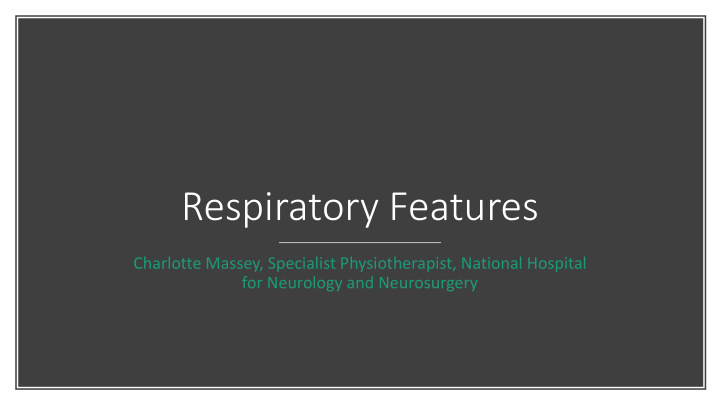



Respiratory Features Charlotte Massey, Specialist Physiotherapist, National Hospital for Neurology and Neurosurgery
Breathing Respiratory failure is the most common cause of death in MND. • Increased use of muscles accessory muscles • Increased respiratory rate • Shallow breathing • Weak cough • Weak sniff
Effects of respiratory failure • breathlessness (dyspnoea) even when at rest or lying flat (orthopnoea) • non refreshing/disturbed sleep • morning headaches • fatigue • poor speech volume • decreased appetite • impaired concentration and/or memory • confusion • nightmares and hallucinations.
Support you can give • Positioning • Ventilation and steady temperature • Encourage calm and purposeful breaths • Breathing exercises where appropriate • Medication • Referral to GP or neurologist where management not possible
JIC Kit • The MND Association Just in Case Kit is designed to hold medication for the relief of anxiety and breathlessness • Order through: MND Connect 0800 802 6262
Use of oxygen in MND • Oxygen should only be used for people living with MND under guidance from the person’s specialist team
Assisted ventilation • NIV • IV • Withdrawal
Coughing and chest clearance Increased chance of chest infections • Breath Stacking • Lung Volume Recruitment (LVR) • Mechanical Insufflator/Exsufflator (MI:E)
Sleeping difficulties • Change position • Smooth sheets • Profiling bed • Extra body support • Distribute body pressure more evenly • Extra pillows • Avoid over-exertion, caffeinated drinks, smoking and heavy meals before bed • Routine • Quiet, cool, dark
Further info • Just in Case kit • NICE Guideline NG42 • MyNIV • Withdrawal of assisted ventilation
More recommend